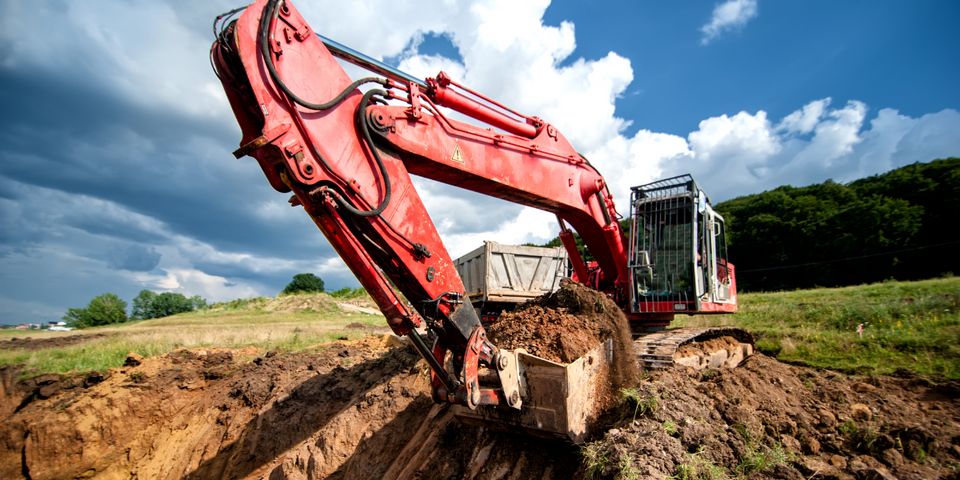Some Known Facts About Concrete Contractors.
Wiki Article
The 5-Second Trick For Excavating Contractors
Table of ContentsFascination About ExcavatorThe Main Principles Of Demolition 10 Easy Facts About Grading Contractors Shown7 Simple Techniques For Excavating ContractorsThe smart Trick of Demolition That Nobody is Discussing


Scrapers or Pans dig deep into soil in one location, haul as well as dump the soil in an additional area (excavator). It is tough to match the efficiency of scrapers for cut/fill dirt procedure if the haul distance is much less then a mile. Scrapers are normally pulled by a rubber tire wheel tractor and also are sometimes pressed via the cut location by an excavator.
There are lots of times that scrapers are not utilized for website grading as well as a dump vehicle is employed: the haul may be to long, the haul might cross roads where scrapes are not permitted, acid rock may be come across, tools availability, etc. Discard vehicles remain in typical use as well as most likely need little discussion.
Several trucks have a top-hinged tailgate that can not dump any kind of rock wider after that the tailgate width. "Rock body" beds, on the other hand, have no tailgates and also can dump any kind of size rock, although their volume ability is diminished. These web links reveal tools requirements for a number of typical dump vehicles. Compaction Equipment raises the thickness of the soil as well as sometimes provides a smooth, rolled surface.
The Basic Principles Of Excavation Companies
From a basic examination pit to percussion drilling to core drilling the owner has increasingly a lot more costly options that produce increasingly better information about the site underground. The Proprietor on a 100,000 SF structure job may license twenty uninteresting places with split spoon dirt examples taken till rock is gotten to as well as after that core samples of rock.Knowing the kind and quality of rock (from the core samples) and also area of rock (from the soils boring) is an actual benefit in jobsite preparation. On the other hand, the Owner of a 100,000 SF building might decide to wage no geotechnical screening whatsoever. The decision concerning geotechnical testing is normally made by an Owner without any input from the Building Manager.
The section on Dirts as well as Geology helps you recognize the terms in the geotechnical record. A knowledge of the approximate area of the rock aids the Building and construction Manager to prepare the sequence of steps following rock excavation. If rock remains in one edge of a huge building task, for example, the earth excavation might start at the opposite end of the structure in order to begin foundation work soonest.
Starting the structure work early would be a good concept if the rock might be eliminated by ripping. If the rock is incredibly difficult and also needs substantial blasting, it might be prudent to hold structure work till the blasting is finished. The Building and construction Supervisor need to coordinate these sorts of choices and use all the technical date readily available.
Facts About Trencher Revealed
Unidentified excavation specifies that all rock or other unforeseen products (leaving out hazardous materials) run into in the sitework will certainly be residential excavation the obligation of the Specialist at no adjustment in agreement price. An unidentified excavation is simpler from a book-keeping standpoint and places the responsibility for geotechnical conditions onto the Sitework Service provider.Exactly How Water Influences Sitework? It's outstanding what a hefty rainfall can do to a construction project. Before the rain, the website may be dry, hefty tools effectively moving earth, the various other professions efficiently performing their job. Within hours the job can be a careless, mud-hole with worker performance reduced to about 10%.
In a lot of areas of the world, the Building and construction Manager must keep in mind a basic fact: IT WILL RAIN. Great planning can decrease the damage as well as disruption of a hefty rain to a jobsite. Commonly the excavation and also grading is left to the Sitework Contractor (and their Foremen is liable to manage and also direct the heavy devices and operators).
The Construction Supervisor need to be constantly mindful of what rain will do to the project site. It is not uncommon for the Sitework Foreman to function their heavy devices for optimal effectiveness and hope it does not rainfall. Among the best methods to prepare for rainfall is to slope all grades to drain pipes and also to smooth rolled the surface area before a rainfall.
The 10-Second Trick For Excavating Contractors
The Building Supervisor have to be discerning adequate to insure that heavy rain does not quit working on the task much longer than needed. Daily discussions with Sitework Foremen might be called for to achieve this goal. At any time excavation is called for listed below the existing groundwater level on a project, the process of dewatering should be considered.In an absolutely cohesive Home Page soil, the water travels so slowly with the clay or silt that dewatering is not normally necessary for the fairly brief time of excavation. Dewatering may be needed for a solitary footing excavation or for a whole job website. The most common dewatering approaches are trench drains pipes, deep wells and well factors.

Ground water seepage can also be lowered by cutoff approaches such as sheet piling. The expenses for dewatering can be astonishing, including devices rental, labor as well as electrical energy (or gas). High dewatering expenses have paled the profit margins on much a lot of projects. The several variables listed here make the job of estimating dewatering prices really challenging, as well as very inexact.
This choice needs to constantly be considered when analyzing the possibility of dewatering. Certainly the option is only viable if gravity can run the water to reduced ground. Trench drains pipes can be cut with a backhoe as well as loaded with a crude, granular material (# 4 stone as an example), but treatment should be worked out in choosing the water outlet type as well as place.
The Main Principles Of Excavating Contractors
A siphon, by definition, makes use of air pressure to lug water from one altitude, up over a challenge, to a reduced elevation. The pipelines in a siphon system should be impermeable and also some ingenuity is commonly needed to totally load the siphon pipe. The siphon pipe have to be full for the siphon to start.A deep well contains a pump, hose and also an upright well casing. The pump consumption is at the bottom of the well covering (usually some smashed rock is put down there as a filter medium) (excavation companies). The water is pumped up the hose pipe, out of the well case, and also to an appropriate discharge place.
In a crude sand, for example, a large location can be pumped to near the pump consumption elevation. A much less permeable dirt, on the other hand, reduces the efficiency of a deep well. Because the pump is normally at the end of the deep well, there are no elevation constraints due to vacuum lift, and deep wells can decrease the groundwater over 50 feet.
Under of the wellpoint there is a 2 foot long screen and shutoff, water jets out of this shutoff as well as develops an opening into which the wellpoint pipe can be reduced. This hole is frequently made a larger diameter (for instance 10 inches) to permit a rugged sand backfill to site link aid filter the water (excavator).
Report this wiki page